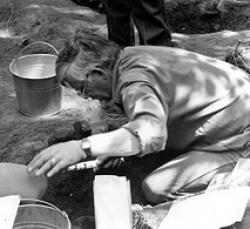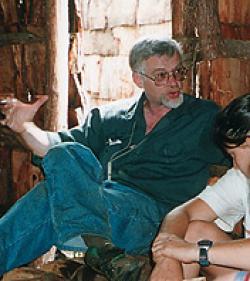

Let me state right away that we were not boyhood friends or student companions. Nor did we ever team up for any field work except briefly in 1983 to testpit a cave on Île d'Orléans, downstream from Quebec. Ours was essentially a career friendship at long distance, with Norman an anthropology professor at the Université de Montréal, and me an archaeologist at the Ministère des Affaires culturelles in Quebec City. So I don't have a basketful of lively anecdotes to recount today and shall happily leave this task to others who knew him on a more regular basis. And yet over a period of several decades, starting in the Seventies, he and I managed to develop and to maintain a warm comradeship based especially on a common goal, shared with a number of other colleagues, namely to promote the study of prehistory within Quebec itself, rather than elsewhere, such as the Mediterranean, the Far East, or Central America, and to ensure that local practices met the standards of a professional discipline.
Although we saw each other infrequently, mainly to discuss collaborative ventures in publication or to work on the organization of conferences, we kept in touch regularly, mostly by telephone or snail-mail, but never by email. Norman had no use for cyberspace communication and considered it a thorough nuisance. Astonishingly enough, but true to form, he published a short article in 1980 outlining the possible uses of the computer for archaeological studies, but obstinately refused to acquire a personal computer for himself. His data base consisted of thousands upon thousands of 5 x 8 index cards which he filled by hand with notes and reflections on given topics. Early on as a student he discovered that this particular form of activity helped to stimulate a steady flow of creative thought, and he never thereafter deviated from it. I have a hunch that Norman's decision to retire this year came about because the Université de Montréal is considering cutting back on its support staff, and soon there will no longer be secretaries to type up his manuscripts. Rumour has it that his wife is now on standby…
Throughout his entire career, which spans more than three decades, Clermont occupied a place in the very forefront of Quebec archaeology. He did not reach this pre-eminent position by dint of academic infighting and by elbowing others aside. He did it through pure force of character. If I had to sum him up in a single phrase it would be: “a man at ease with himself”, and therefore able to quickly put others at ease. One never senses any hint of personal insecurity and a need for self-inflation. What you see is what you get. And what you get and hear is a cerebral tornado equipped with a booming voice and a joyous disposition. Initially, no doubt, new students must have felt intimidated by his presence, only to have this feeling eventually transformed into affectionate admiration and respect.
Norman's frontline place of honour was voluntarily ceded to him by his peers in recognition of his exceptional qualities of leadership, his breadth of vision, his unbounded energy, and his magisterial talents as a teacher. He combined all of these to become the principal architect of the professionalization process which Quebec prehistory research underwent during the second half of the 20th century. Rare indeed are the present day practitioners of this discipline in Quebec who have not in some way been influenced by him as graduate students in either classroom, field school or excavation projects, or through his numerous writings.
In 1982, Clermont published an article in the Canadian Journal of Archaeology outlining the progress that had been made in Quebec archaeology over a period of several decades. He gave it the rousing title “QUEBEC PREHISTORY COMES MARCHING IN”. What Norman omitted to make explicit, however, was that he himself had been leading the parade all along, serving as Grand Marshal.
In a profession noted for its uninspired verbosity, his articles tend to be crisp and lean, but always sparkling with insights. For example, writing for the journal Recherches amérindiennes au Québec in 1999, he set down in 2+ pages, all that you will ever really want to know about the subject of Archaeology and Ethnicity. I for one have always been impressed by his gifted way with the written word and the sonorous quality he succeeds in imparting. Indeed, his articles might well be described as archaeological preludes, impromptus, waltzes and mazurkas. This is not to say, however, that he is exclusively a minimalist. A whole series of monographs, co-authored with others, testify to his capacity for both exhaustive observation and far ranging interpretation.
In closing, it might be appropriate to touch briefly on the connections which both Harlan I. Smith and William Wintemberg had with Quebec archaeology during the first half of the 20th century. Smith worked as an archaeologist for the Geological Survey of the Department of Mines in Ottawa, and was the first person to compile a bibliography of Canadian prehistory, including Quebec. During the autumn of 1911 he corresponded with Mr. Fred Wurtele, the secretary of the Quebec Branch of the Archaeological Institute of America, an organization which had as one of its primary aims the diffusion of knowledge about classical archaeology to the general public. In his letter, Smith outlined what might be termed a program of pragmatic archaeology:
I have recently taken up the archaeological work for the Dominion Government and I am organizing a research survey as well as preparing exhibits for the public. Although not having unpacked everything, I find that we have a very good representative collection from the coast of British Columbia, also from the plateaus, and we have so much material from Ontario that I expect a representative collection can be made up from that, but from Manitoba and the Plains, Quebec, and the Atlantic seaboard we have so little that I feel that it is my duty to the people of these regions especially, and the Government to increase our collections from those places and carry out explorations in them. This, of course, I cannot profitably do until I know of places where it will pay to excavate. I have been making an index of such places and know of many such in British Columbia and Ontario, some in Manitoba, but practically none in Quebec. I am hoping that you will be able to know of some places so that I may visit them next year in the hopes that one of them will be deep enough so that the objects scattered in it may many of them lie below the depths disturbed by the plough, an that it will be large enough so that it will be economical to employ three or four men and dig for several months with the expectation of getting enough information for the basis of a monograph on that one place, and enough material so that we may make a representative exhibit in the national museum of the place, and have duplicate specimens for many other Canadian museums.
Smith never made it to Quebec for any fieldwork. However, William Wintemberg did manage to do so during the nineteen twenties and thirties when he conducted extensive surveys within the lower St. Lawrence River valley, along the Quebec North Shore as far as the Strait of Belle Isle, and even on the Magdalen Islands. As such, he was the first researcher to provide an idea of the extent and variety of Quebec's prehistoric heritage. During the second half of the 20th century an increasing number of other scholars, Norman amongst them, made significant contributions to Quebec prehistory. In this connection, whether we can assign the formal title “Father of Quebec Archaeology” to anyone in particular is questionable and most probably irrelevant. After all, names such as the Fathers of Confederation and the Mothers of Invention indicate that combined efforts tend to be the rule. For Quebécois archaeologists, however, I strongly suspect that Norman Clermont is, and always will remain, the Biggest Daddy of us all.
Charles A. Martijn
12 May, 2002
